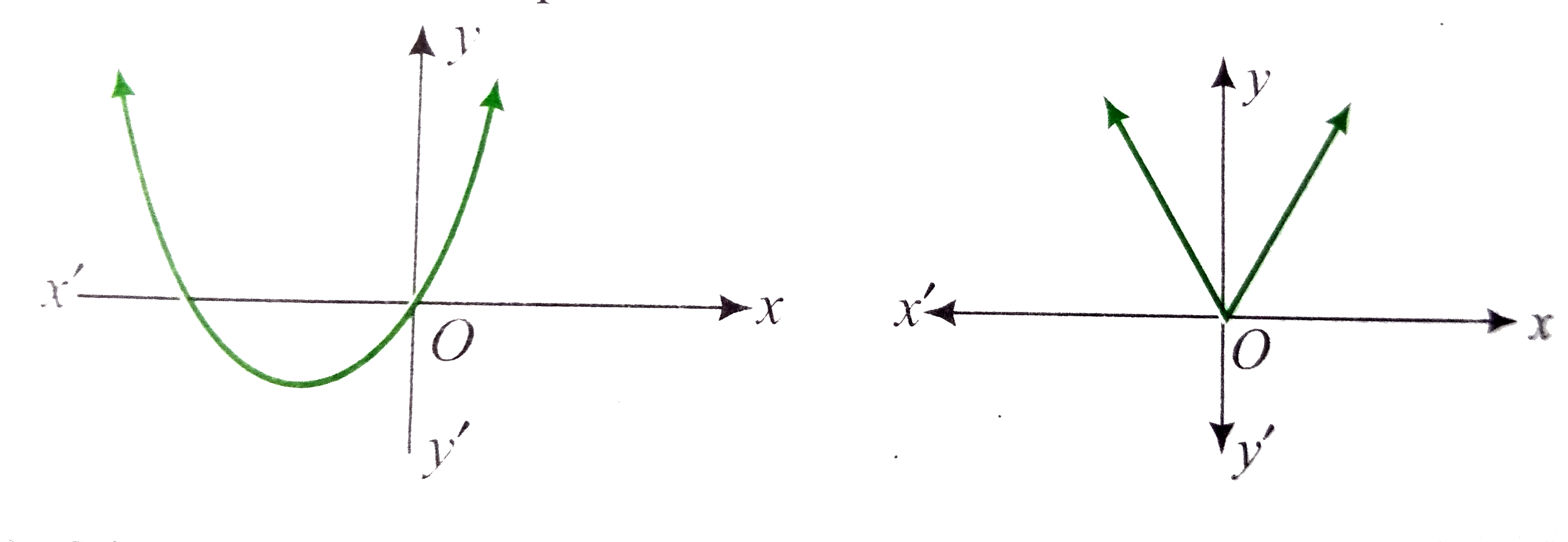If the equaion x2+ax+b=0 has distinct real roots and x2+a|x|+b=0 has only one real root, thenSolution in Bengali
b=0,a>0
b = 0, a < 0
b>0,a<0
b<0,a>0
The correct Answer is:1
Since the equation x2+ax+b=0 has distinct real roots and
x2+a|x|+b=0 has only one real root, so one root of the
equation x2+ax+b=0 will be zero and other root will be
negative . Hence b = 0 and a>0 .
Graph of y=ax2+bx+c according Graph of y=ax2+b|x|+c
to conditions given in question

Topper's Solved these Questions
- BOOK - CENGAGE PUBLICATIONCHAPTER - THEORY OF EQUATIONSEXERCISE - Multiple Correct Answer Type38videos
THEORY OF EQUATIONS
- BOOK - CENGAGE PUBLICATIONCHAPTER - THEORY OF EQUATIONSEXERCISE - Linked Comprechension Type37videos
THEORY OF EQUATIONS
- BOOK - CENGAGE PUBLICATIONCHAPTER - THEORY OF EQUATIONSEXERCISE - CONCEPT APPLICATION EXERCISE 2.139videos
THEORY OF EQUATIONS
- BOOK - CENGAGE PUBLICATIONCHAPTER - STRAIGHT LINESEXERCISE - ARCHIVES (NUMERICAL VALUE TYPE)1videos
STRAIGHT LINES
- BOOK - CENGAGE PUBLICATIONCHAPTER - THREE DIMENSIONAL GEOMETRYEXERCISE - All Questions291videos
THREE DIMENSIONAL GEOMETRY
Similar Questions
If c≠0 and the equation p2x=ax+c+bx−c has two equal roots, then p can be
04:50View SolutionConsider an unknow polynomial which divided by (x−3) and (x−4) leaves remainder 2 and 1, respectively. Let R(x) be the remainder when this polynomial is divided by (x−3)(x−4).
If equations R(x)=x2+ax+1 has two distint real roots, then exhaustive values of a are.02:58View SolutionFind the values of a if x2−2(a−1)x+(2a+1)=0 has positive roots.
02:22View SolutionFor a point P in the plane, let d1(P)andd2(P) be the distances of the point P from the lines x−y=0andx+y=0 respectively. The area of the region R consisting of all points P lying in the first quadrant of the plane and satisfying 2≤d1(P)+d2(P)≤4, is
03:02View SolutionFind the angle between the line whose direction cosines are given by l+m+n=0andl2+m2−n2=0.
01:23View SolutionIf the equation x2=ax+b=0 has distinct real roots and x2+a|x|+b=0 has only one real root, then which of the following is true? b=0,a>0 b. b=0,a<0 c. b>0,a<0 d. b⟨0,a⟩0
06:06View SolutionIf the equation ax2+bx+c=0 has two positive and real roots, then prove that the equation ax2+(b+6a)x+(c+3b)=0 has at least one positive real root.
02:48View SolutionIf the equation ax^(2)+bx+c=0 has distinct real roots and ax^(2)+b{x}+C=0 also has two distinct real roots then
01:35View SolutionIf x^(2)-ax+b=0 where a,b in N has real and distinct roots,then a_(min)+b_(min)=
05:27View SolutionShow that the equation x2+ax−4=0 has real and distinct roots for all real values of a .
02:38View SolutionIf the equaion x2+ax+b=0 has distinct real roots and x2+a|x|+b=0 has only one real root, then
02:53View SolutionIF the equation x2+5x+K=0 has no real and distinct roots, then………
View SolutionIf the equation x2+5x+K=0 has real and distinct roots, then….
View SolutionIf the equation x2=ax+b=0 has distinct real roots and x2+a|x|+b=0 has only one real root, then which of the following is true? b=0,a>0 b. b=0,a<0 c. b>0,a<0 d. b⟨0,a⟩0
05:46View SolutionIf the equation ax2+bx+c=0 has two positive and real roots, then prove that the equation ax2+(b+6a)x+(c+3b)=0 has at least one positive real root.
07:19View SolutionIf the equaion x2+ax+b=0 has distinct real roots and x2+a|x|+b=0 has only one real root, then
05:23View Solution

